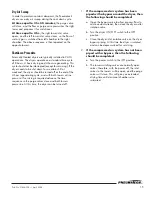
Pub. No. OM-A-10E — April 2004
23
TROUBLESHOOTING
Table 1 — Troubleshooting Guide for Regenerative Dryers
Symptoms
Cause
Remedy
A. Elevated Dewpoint.
1. Low purge flow.
2. Low inlet pressure.
3. Excess moisture carryover.
4. High inlet temperature.
5. Excess air/gas inlet flow.
6. Desiccant coated with oil.
7. Regeneration temperature low.
8. Dewpoint monitor out of
calibration.
1. Reset purge pressure at the
recommended pressure.
2. Recalculate purge pressure setting
from the chart.
3. Check prefilter element. Check
drains at prefilter and afterfilter.
4. Check aftercooler operation.
5. Check total output of compressors.
6. Depressurize dryer and inspect
desiccant.
7. *See B.
8. Recalibrate probe.
B. Regeneration temperature low
(Normal 250°F).
1. Thermostat faulty or set too low.
2. Low purge flow.
3. Back pressure on regenerating
tower.
4. Heater burnout.
5. Contactor faulty.
6. No power.
7. Insufficient heating period.
1. Reset thermostat or replace if
necessary.
2. *See A1.
3. *See C1.
4. Check heater, replace if
necessary.
5. Replace heater contactor.
6. Check for continuity.
7. (Contact factory).
C. High back pressure on regenerat-
ing tower.
NOTE:
The tower should be at ‘0’
PSIG during regeneration cycle. Any
back pressure will result in improper
regeneration.
1. Muffler plugged.
2. Check valves leaking.
NOTE:
To test for leaking check valves
during regeneration cycle, shut the
purge adjusting valve. If gas is still
passing through, it is an indication of
leaking check valves.
3. Excess purge flow.
4. Restricted purge exhaust piping.
5. Too high purge.
6. Diaphragms ruptured in values
(EE models).
1. Replace mufflers.
2. Repair or replace faulty check
valves.
3. Check and reset the purge
pressure.
4. Remove obstruction or replace
with larger size pipe.
5. Check purge calibration, plot and
reset.
6. Replace diaphragms.




































